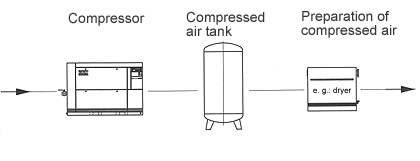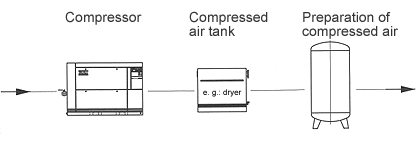|
6.7 Compressed-air tanks
Within the compressed-air network the compressed-air tank has the following
functions:
- pulsation and pressure compensation
- condensate trapping
- storage of compressed air
Screw compressors do not need pulsation compensation by the compressed-air
tank any longer.
Basically, there are two kinds of installation of the compressed-air tank:
1. Compressor - compressed-air tank - preparation of
compressed air

Advantages: The compressed-air tank causes pre-cooling and condensate abstraction
before the dryer. The dryer is getting relieved having a positive influence on its
performance.
This installation will be recommended if continuous consumption of compressed air takes place.
2. Compressor – compressed-air tank – preparation of compressed air

Advantages: The compressed-air tank is filled with dried compressed air. Because of this
there is no condensate or corrosion in the compressed-air tank.
This installation will be recommended if an irregular consumption of the compressed air takes place, which might be briefly shorter than the volume supplied by the compressor.
Correct size of the compressed-air tank
The correct or necessary size of the compressed-air tank depends on:
· volume flow of the compressor
·
suction pressure of the compressor
·
setting of compressed air switch
(pressure difference of the compressor
within a switching cycle)
·
temperature of the compressed-air tank
·
temperature of the compressor suction air
·
switch-on frequency or cycle frequency of the compressor
The following standard values apply to the size of the compressed-air tank
for compressed-air blasting:
Volume flow 5 m3/min => up to 2 m3 tank size
Volume flow 10 m3/min => up
to 4 m3 tank size
Volume flow 20 m3/min => up to 6 m3 tank size
6.8 Leakages
result in losses of the amount to be supplied
and losses by unnecessarily used compressor operating
energy input.
They cause costs which could be avoided.
Values at an operating pressure of 7 b:
1 mm diameter
= 1.238 l/s loss
= 0.4 kW actual power
3 mm diameter
= 11.14 l/s loss
= 4.0 kW actual power
5 mm diameter
= 30.95 l/s loss
= 10.8 kW actual power
10 mm diameter
= 123.8 l/s loss
= 43 KW actual power
|



